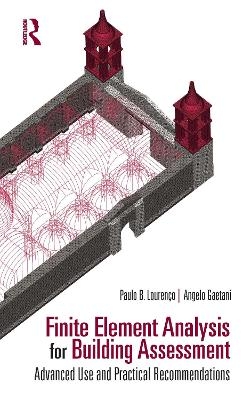
Finite Element Analysis for Building Assessment
Advanced Use and Practical Recommendations
Seiten
2022
Routledge (Verlag)
978-0-367-35767-2 (ISBN)
Routledge (Verlag)
978-0-367-35767-2 (ISBN)
This presents the Finite Element Method, outlining nonlinearities in computational terms. It advises the material properties to be adopted in the analyses, and is illustrated with cases studies of existing buildings. For students with a background in structural engineering, and professionals.
Existing structures represent a heterogeneous category in the global built environment as often characterized by the presence of archaic materials, damage and disconnections, uncommon construction techniques and subsequent interventions throughout the building history. In this scenario, the common linear elastic analysis approach adopted for new buildings is incapable of an accurate estimation of structural capacity, leading to overconservative results, invasive structural strengthening, added intervention costs, excessive interference to building users and possible losses in terms of aesthetics or heritage values. For a rational and sustainable use of the resources, this book deals with advanced numerical simulations, adopting a practical approach to introduce the fundamentals of Finite Element Method, nonlinear solution procedures and constitutive material models. Recommended material properties for masonry, timber, reinforced concrete, iron and steel are discussed according to experimental evidence, building standards and codes of practice. The examples examined throughout the book and in the conclusive chapter support the analyst’s decision-making process toward a safe and efficient use of finite element analysis.
Written primarily for practicing engineers, the book is of value to students in engineering and technical architecture with solid knowledge in the field of continuum mechanics and structural design.
Existing structures represent a heterogeneous category in the global built environment as often characterized by the presence of archaic materials, damage and disconnections, uncommon construction techniques and subsequent interventions throughout the building history. In this scenario, the common linear elastic analysis approach adopted for new buildings is incapable of an accurate estimation of structural capacity, leading to overconservative results, invasive structural strengthening, added intervention costs, excessive interference to building users and possible losses in terms of aesthetics or heritage values. For a rational and sustainable use of the resources, this book deals with advanced numerical simulations, adopting a practical approach to introduce the fundamentals of Finite Element Method, nonlinear solution procedures and constitutive material models. Recommended material properties for masonry, timber, reinforced concrete, iron and steel are discussed according to experimental evidence, building standards and codes of practice. The examples examined throughout the book and in the conclusive chapter support the analyst’s decision-making process toward a safe and efficient use of finite element analysis.
Written primarily for practicing engineers, the book is of value to students in engineering and technical architecture with solid knowledge in the field of continuum mechanics and structural design.
Paulo B. Lourenço is Professor at University of Minho, Portugal. He is Head of the Institute in Sustainability and Innovation in Structural Engineering, and an expert in structural conservation and forensic engineering. Dr. Angelo Gaetani is a professional structural engineer and consultant in Rome, Italy, who leads structural restoration and seismic retrofit projects. He was a postdoctoral research fellow until 2020 at University of Minho, Portugal.
1. Fundamentals of the Finite Element Method. 2. Nonlinear Structural Analysis. 3. Constitutive Models. 4. Recommended Properties for Advanced Numerical Analysis. 5. Guidelines for Practical Use of Nonlinear Finite Element Analysis.
| Erscheinungsdatum | 03.05.2022 |
|---|---|
| Reihe/Serie | Assessment, Repair and Strengthening for the Conservation of Structures |
| Zusatzinfo | 79 Tables, black and white; 43 Line drawings, black and white; 502 Halftones, black and white; 545 Illustrations, black and white |
| Verlagsort | London |
| Sprache | englisch |
| Maße | 156 x 234 mm |
| Gewicht | 940 g |
| Themenwelt | Naturwissenschaften ► Biologie ► Ökologie / Naturschutz |
| Technik ► Architektur | |
| Technik ► Bauwesen | |
| Technik ► Umwelttechnik / Biotechnologie | |
| ISBN-10 | 0-367-35767-4 / 0367357674 |
| ISBN-13 | 978-0-367-35767-2 / 9780367357672 |
| Zustand | Neuware |
| Haben Sie eine Frage zum Produkt? |
Mehr entdecken
aus dem Bereich
aus dem Bereich
Lehrbuch zu Grundlagen, Technologie und Praxis
Buch | Hardcover (2022)
Hanser (Verlag)
34,99 €


